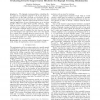Free Online Productivity Tools
i2Speak
i2Symbol
i2OCR
iTex2Img
iWeb2Print
iWeb2Shot
i2Type
iPdf2Split
iPdf2Merge
i2Bopomofo
i2Arabic
i2Style
i2Image
i2PDF
iLatex2Rtf
Sci2ools
ISCAS
1999
IEEE
1999
IEEE
Evaluating iterative improvement heuristics for bigraph crossing minimization
The bigraph crossing problem, embedding the two node sets of a bipartite graph G = V0;V1;E along two parallel lines so that edge crossings are minimized, has application to placement optimization for standard cells and other technologies. Iterative improvement heuristics involve repeated application of some transformation on an existing feasible solution to obtain better feasible solutions. Typically an increase in the number of iterations, and therefore execution time, implies an improvement in solution quality. We investigate tradeo s between execution time and solution quality in order to establish the best heuristic for any given time budget. Our experiments show some clear trends for a scalable class of graphs based on actual circuits. These trends, based on statistically signi cant samples of each of several graph graph sizes, suggest promising directions for development of better heuristics.
| Added | 04 Aug 2010 |
| Updated | 04 Aug 2010 |
| Type | Conference |
| Year | 1999 |
| Where | ISCAS |
| Authors | Matthias F. M. Stallmann, Franc Brglez, Debabrata Ghosh |
Comments (0)

